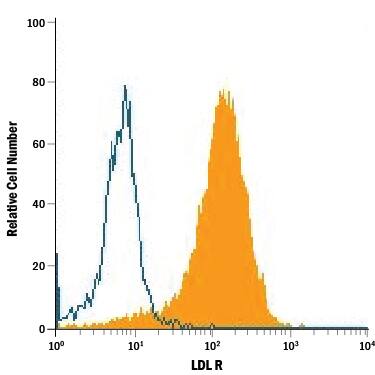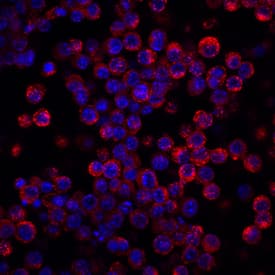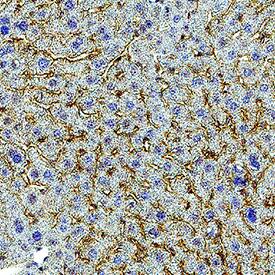Mouse LDLR Biotinylated Antibody
R&D Systems, part of Bio-Techne | Catalog # BAF2255


Key Product Details
Species Reactivity
Validated:
Cited:
Applications
Validated:
Cited:
Label
Antibody Source
Product Specifications
Immunogen
Ala22-Arg790 (Ala23Val, Cys27Gly)
Accession # Q6GTJ9
Specificity
Clonality
Host
Isotype
Scientific Data Images for Mouse LDLR Biotinylated Antibody
Detection of LDL R in RAW 264.7 Mouse Cell Line by Flow Cytometry.
Serum-deprived RAW 264.7 mouse monocyte/macrophage cell line was stained with Goat Anti-Mouse LDL R Biotinylated Antigen Affinity-purified Polyclonal Antibody (Catalog # BAF2255, filled histogram) or isotype control antibody (Catalog # BAF108, open histogram), followed by Streptavidin-PE (Catalog # F0040).LDL R in RAW 264.7 Mouse Cell Line.
LDL R was detected in immersion fixed RAW 264.7 mouse monocyte/macrophage cell line using Goat Anti-Mouse Anti-LDL R Biotinylated Antigen Affinity-purified Polyclonal Antibody (Catalog # BAF2255) at 10 µg/mL for 3 hours at room temperature. Cells were stained using the NorthernLights™ 557-conjugated Streptavidin (red; Catalog # NL999) and counterstained with DAPI (blue). View our protocol for Fluorescent ICC Staining of Cells on Coverslips.LDLR in Mouse Liver.
LDLR was detected in immersion fixed paraffin-embedded sections of mouse liver using Goat Anti-Mouse LDLR Biotinylated Antigen Affinity-purified Polyclonal Antibody (Catalog # BAF2255) at 10 µg/mL for 1 hour at room temperature followed by incubation with the Anti-Goat IgG VisUCyte™ HRP Polymer Antibody (VC004). Before incubation with the primary antibody, tissue was subjected to heat-induced epitope retrieval using Antigen Retrieval Reagent-Basic (CTS013). Tissue was stained using DAB (brown) and counterstained with hematoxylin (blue). Specific staining was localized to cell membrane in sinusoids. Staining was performed using our protocol for IHC Staining with VisUCyte HRP Polymer Detection Reagents.Applications for Mouse LDLR Biotinylated Antibody
Flow Cytometry
Sample: Serum-deprived RAW 264.7 mouse monocyte/macrophage cell line
Immunocytochemistry
Sample: Immersion fixed RAW 264.7 mouse monocyte/macrophage cell line
Immunohistochemistry
Sample: Immersion fixed paraffin-embedded sections of mouse liver
Western Blot
Sample: Recombinant Mouse LDL R (Catalog # 2255-LD)
Formulation, Preparation, and Storage
Purification
Reconstitution
Formulation
Shipping
Stability & Storage
- 12 months from date of receipt, -20 to -70 °C as supplied.
- 1 month, 2 to 8 °C under sterile conditions after reconstitution.
- 6 months, -20 to -70 °C under sterile conditions after reconstitution.
Background: LDLR
The low density lipoprotein receptor (LDL R) is the founding member of the LDL R family of scavenger receptors (1, 2, 3, 4). This family contains type I transmembrane molecules that are characterized by the presence of EGF repeats, complement-like repeats, and YWTD motifs that form beta-propellers. Although members of the family were originally thought to be endocytic receptors, it is now clear that some members interact with adjacent cell-surface molecules, expanding their range of activities (2, 4). Mouse LDL R is synthesized as a 864 amino acid (aa) precursor that contains a 21 aa signal sequence, a 769 aa extracellular region, a 22 aa transmembrane segment and a 52 aa cytoplasmic tail (5). The extracellular region is complex. It consists of seven N-terminal complement-like cysteine-rich repeats (class A LDL domains) that bind LDL. Cysteines in this region participate in intrachain disulfide bonds. This region is followed by two EGF-like domains and six class B LDL repeats that generate a beta-propeller whose blades each contain a YWTD motif. This area is likely responsible for ligand dissociation (6). Finally, there is a 50 aa membrane proximal Ser/Thr-rich region that shows extensive O-linked glycosylation, generating a native molecular weight for LDL R of 135 kDa (5). Within the 52 aa cytoplasmic region, there is an NPxY motif that links the receptor to clathrin pits and binds to select adaptor proteins (1, 7, 8). The extracellular region of mouse LDL R shares 78% and 87% aa identity with the extracellular region of human and rat LDL R, respectively. LDL R is constitutively expressed and binds apoB of LDL and apoE of VLDL (9). It is responsible for clearing 70% of plasma LDL in liver (9).
References
- Strickland, D.K. et al. (2002) Trends Endocrinol. Metab. 13:66.
- Nykjaer, A. and T.E. Willnow (2002) Trends Cell Biol. 12:273.
- Gent, J. and I. Braakman (2004) Cell. Mol. Life Sci. 61:2461.
- Bujo, H. and Y. Saito (2006) Arterioscler. Thromb. Vasc. Biol. 26:1246.
- Hoffer, M.J. V. et al. (1993) Biochem. Biophys. Res. Commun. 191:880.
- Rudenko, G. and J. Deisenhofer (2003) Curr. Opin. Struct. Biol. 13:683.
- Trommsdorff, M. et al. (1998) J. Biol. Chem. 273:33556.
- Stolt, P.C. and H.H. Bock (2006) Cell. Signal. 18:1560
- Defesche, J.C. (2004) Semin. Vasc. Med. 4:5.
Long Name
Alternate Names
Entrez Gene IDs
Gene Symbol
UniProt
Additional LDLR Products
Product Documents for Mouse LDLR Biotinylated Antibody
Product Specific Notices for Mouse LDLR Biotinylated Antibody
For research use only

